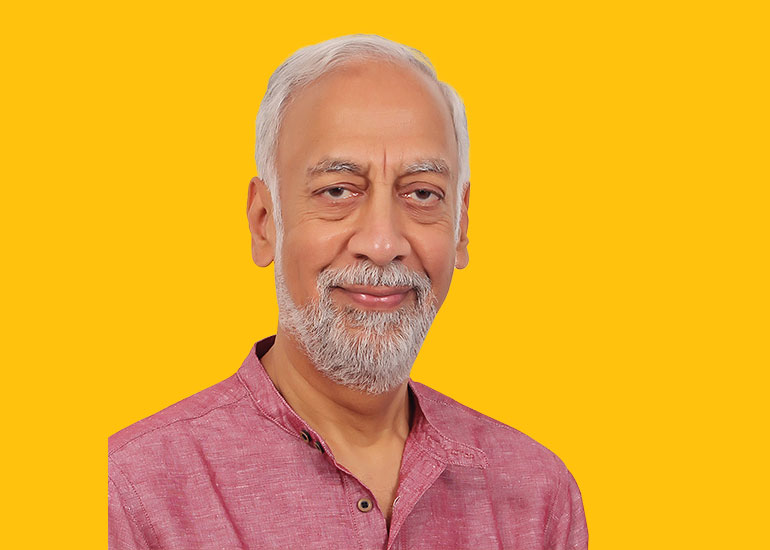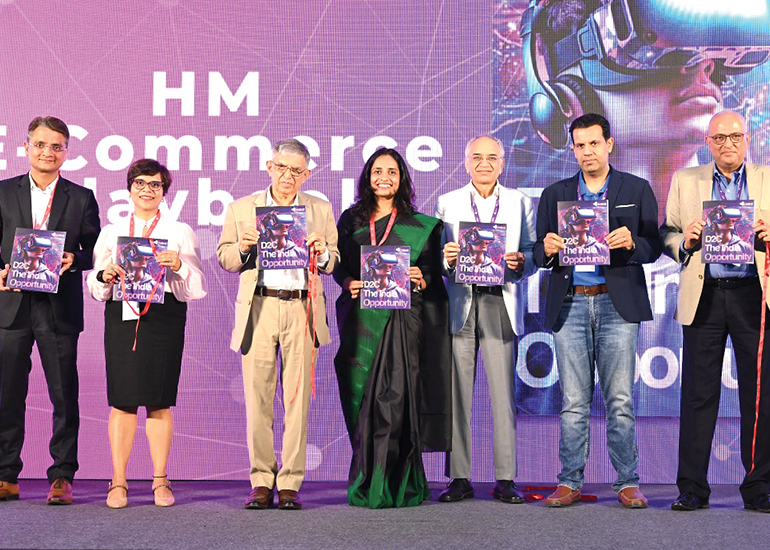BIRTH OF A STAR
As Piyush Pandey hands over the baton of Executive Chairman at Ogilvy, Chintamani Rao, Strategic Marketing and Media Consultant recounts the story of an account supervisor who rose to creative superstardom.
It was 1986. Piyush Pandey was an Account Supervisor working with me on, among others, Hindustan Lever.
We had a brief on Sunlight Detergent Powder, on which our response was overdue. Young Piyush, meanwhile, was itching. He came to me one morning with a script he had written. Not only was it spot on, but, back in the day when advertising was written in English by Stephanians (Piyush is one, too) and Xavierites and their ilk, and translated into Indian languages by freelancers, he had written it in – lo! and behold – Hindi.
We were out of time and we had a solution in hand, so, like a good account man, even at the risk of annoying our beloved Creative chief Suresh Mullick, I told him to go ahead. He developed that script and two others, and off we went to present them.
Sanjay Khosla (later a big cheese at Kraft) was the client. He liked the scripts and approved them, but was curious. Never before had the agency presented work in anything but English. He asked who the writer was. Naively unprepared for the question, we shuffled our feet and mumbled something about this new guy we had.
I went to Suresh and confessed. Far from being upset, he guided Piyush to refine the scripts, supported him, and gave him full Creative responsibility to make the three films for Sunlight. (That was Suresh!)
And that, boys and girls, was how Piyush Pandey wrote and made his first ads, as an Account Supervisor.
It naturally followed that he was called on now and then for his input on one brief or another. He went on to work on Fevicol (work much lauded and much awarded over the years), Luna mopeds, and, of course, Sunlight. His big breakthrough came in 1988, when he wrote the unforgettable lyrics for Mile Sur, the second of Suresh Mullick’s three Independence Day films.
In time, his account management role was just Piyush’s day job; creating film scripts was his night job, and what kept him charged. In 1990 Ashish Mitra, as head of the Bombay office (I had transferred to Bangalore) initiated the move to a transition. Ashish’s tenure in Ogilvy was brief and unhappy, but it was the beginning of what changed the face of Indian advertising.
The triumvirate who ran Ogilvy were not enthused. Writing a few film scripts was one thing: a full-time Creative job was quite another.
Suresh great worry was that Piyush would never make it to Creative Director. He wrote terrific films but had never written a print ad, the true expression of the copywriter’s craft. Nor could Suresh see him making a formal Creative presentation. Consequently, he would be left languishing as a middle-level writer of Hindi copy. And where would he start? Obviously not as a junior copywriter, but, on the other hand, he did not yet have the credentials to lead a team.
Suresh’s concerns were a reflection of the times, not of his opinion of Piyush. He loved Piyush and was proud of him, and it was his guidance, encouragement and support that had made the journey thus far possible. But TV was still a relatively new medium. Historically, campaigns were first developed in print, and presentations led with print ads, followed by TV and other media, in English. So what was the future for a writer who was strong in TV but didn’t write print, and wrote in Hindi but not in English?
Yet, nothing is more powerful than an idea whose time has come, as Victor Hugo said. This was such an idea, and a beginning was made. Piyush was appointed Indian Language Copy Chief so he could render (‘transcreate’ was the word those days) English originals into Hindi, and guide and oversee the freelance translators who did the other languages. He was not expected to write much original advertising, except for a few brands like Sunlight, Luna, and Fevicol.
Given time and the space, Piyush showed what he was capable of. In a couple of years he was appointed Creative Director for Bombay. At the end of 1993 came a change of guard. Mani Ayer retired, after a long, illustrious, and eventful tenure as Managing Director, and Ranjan Kapur returned from Singapore to succeed him.
Ranjan had the advantage of being an insider-outsider. He had moved out into the Ogilvy network and worked across borders in an international role, yet had remained a close observer of the Indian company. He had his own vision and ambition for Ogilvy India, and a creative renaissance was integral to that. He saw the potential Piyush represented in helping to transform the agency and drive it. He soon appointed Piyush National Creative Director, and backed him all the way.
This was a whole new way of working and, expectedly, was not popular. In an agency historically driven by Account Management, the Creative rank-and-file acquired a voice and came out of the backroom. Ranjan stuck to his guns in the face of opposition from almost the entire agency. In good time he was proved right. As the profile of the work changed and created a buzz in the industry, and clients were delighted, there was a new excitement in the air. And the rest is, as they say, history.
Piyush has not only impacted Ogilvy, he has, inarguably, driven a change in the face of Indian advertising. What is it about him? Prodigious talent, of course, but that can’t be all.
Much has been said about his small-town sensibilities, coming as he does from Jaipur. There may be something in that, but it is, frankly, patronising. After school at St Xavier’s in Jaipur he went to St Stephen’s College in Delhi for five years, earning an MA in History and playing cricket; and went to work first at a boxwallah tea company in Calcutta and then at Ogilvy in Bombay. So the image of the wide-eyed small-town boy making it in the big city is not quite it.
Cut to the mid-90s. I was back in Bombay. He was National Creative Director, and had been making waves for some years. We were having a beer on the verandah of the Bombay Gymkhana when the CEO of another large advertising agency stopped by. “We’ve been studying your work, and we’ve understood what you do,” he said to Piyush. “It’s the language: the way you use a mix of English and Hindi.” (The word Hinglish was not yet in our lexicon.)
“What a relief,” said Piyush after he left. “I was afraid they’d really understood.”
Our CEO friend had the glimmer of something there, actually. It wasn’t just the language Piyush wrote in, though, it was the language he thought in, and encouraged thinking in, and his ability to make the mental connection. It is only when you think in a language that you get the idiom – verbal, visual, and cultural.
“I said it in Hebrew — I said it in Dutch —
I said it in German and Greek;
But I wholly forgot (and it vexes me much)
That English is what you speak.”
— Lewis Caroll, The Hunting of the Snark
Replace English there with Hindi, Tamil, Bengali, or any other Indian language, and that typified Indian advertising. The few exceptions were just that, exceptions. And at the fringe there was Hinglish and its equivalents, like, “Yehi hai right choice, baby!” When we went back home from work we spoke, watched movies, and listened to music in our own languages, but the language at work was English, and so was the advertising we created. That is what changed. And it was not only in the copy: Hindi or Tamil was increasinsgly heard in agency meetings and discussions, especially those on creative work.
In 1995-96 Neil French, then Regional Creative Director at Ogilvy, visited Bombay and, as is the normal practice, reviewed the agency’s creative work. He confessed that much of it passed him by. But he knew from the clients he had met, and the awards adorning the offices, that it worked powerfully for clients as well as the agency, and decided to leave well enough alone.
The language, and the idiom, was in the expression. Behind that was the quintessential Ogilvy copywriter. Look at Piyush’s own best work, the work that built his career, and you will find two things: a benefit rooted in the product – the category high ground, in David Ogilvy’s terms; and a unique, memorable expression of it. That’s it. An instinctive strategist, as the best Creative people are, he never went logically through the process, but that is what his innate discipline and flair led him to. David Ogilvy would have been proud.
Back when we worked together, Piyush didn’t just walk in with an idea or a script, he came bouncing in, eager to share. He was enthusiastic, yet he was open, never wedded to an idea or to a piece of work: there was more where that had come from. If you went back to where he had started, which you frequently did, that was not because he had insisted that was it.
In the last 30-odd years Piyush has nurtured many a talent, nationally and internationally, as a professional leader must, and many of those he encouraged and gave opportunities to have gone on to become leaders in their own right. Yet he remains special, standing apart from those who came before him as well as those who have come after.
Go well, my friend. Cheers!























